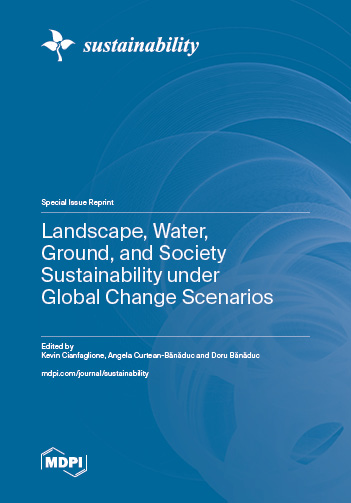Landscape, Water, Ground, and Society Sustainability under Global Change Scenarios
A special issue of Sustainability (ISSN 2071-1050). This special issue belongs to the section "Sustainable Water Management".
Deadline for manuscript submissions: closed (30 June 2022) | Viewed by 30354
Special Issue Editors
Interests: plant biology; ecological, biological and chemical traits; vegetation; ecosystems analysis and dynamics; conservation; restoration ecology; land and natural resources management; traditional uses and new applications
Special Issues, Collections and Topics in MDPI journals
Interests: Freshwater ecology; Bodiversity assessment, monitoring and management; Entomology (Ephemeroptera, Trichoptera, Plecoptera)
Interests: aquatic ecosystems ecology; biodiversity; fish; human impact, assessment; monitoring; management
Special Issues, Collections and Topics in MDPI journals
Special Issue Information
Dear Colleagues,
We would like to invite you to contribute to the Special Issue of Sustainability entitled: “Landscape, Water, Ground, and Society Sustainability under Global Change Scenarios”.
Proposal: In this Special Issue, we accept manuscripts focusing on sustainability; study cases and opinion papers about initiatives, definitions, policies, programs and ideas; traditional knowledge and new applications; criticism and new proposals; natural resource uses, conflicts and growth problems; and issues related to global change (changes in, for example, climate, uses, needs, soil occupation, society, public opinion, species composition, and ecosystems).
Aim and scope: Contributions should focus on landscape, water, ground, and societal characteristics under global change scenarios.
The landscape is the visible feature of land, it integrates natural and man-made features (cultural, social, and economic) and dynamics, at different scales. Ground, water, and society primarily determine the characteristics of the landscape. When at least one of these features changes, the landscape changes. Anthropic dynamics on the landscape are intended as the human past, present or mixed activities that influence the landforms, land elements, and biodiversity or the natural dynamics of biological communities and populations.
Water must be understood as an essential component of life, as a part of all living organisms, habitats, and ecosystems, and as an energy resource. Problems related to water may be direct (water resource assessment, monitoring, management, use, impact, etc.) or indirect (soil uses and slope stability, hydrogeological issues, erosion, floods, etc.).
Ground issues are intended to include soil topics; land occupation; substrate for natural species, agriculture, food, and other product sources; and chemical and ecological changes. The problems related to soil degradation are desertification, saltation, erosion, soil sealing, pollution and other noteworthy chemical changes.
Integrated, multi-, or interdisciplinary analyses or considerations are encouraged.
One or more land characteristics should be the object of study. These may be analyzed in a single context or along gradients (geographic, ecological, cultural, etc.) focusing on present, past or future global change scenarios, in terms of natural, anthropic, or mixed dynamics, considering the possible positive and negative impacts or interactions issues and outlooks (i.e., alien and native species issues; policies and land management; conservation and preservation; habitat restoration; uses and policies changes; adaptations, resilience and resistance; wildfire and post-fire issues; energy supply issues; eco-friendly molecules and techniques; land use conflicts; economic and population growth; urbanization and land abandonment; society development).
Dr. Kevin CianfaglioneGuest Editor
Dr. Angela Curtean-Bănăduc
Dr. Doru Bănăduc
Co-Guest Editors
Manuscript Submission Information
Manuscripts should be submitted online at www.mdpi.com by registering and logging in to this website. Once you are registered, click here to go to the submission form. Manuscripts can be submitted until the deadline. All submissions that pass pre-check are peer-reviewed. Accepted papers will be published continuously in the journal (as soon as accepted) and will be listed together on the special issue website. Research articles, review articles as well as short communications are invited. For planned papers, a title and short abstract (about 100 words) can be sent to the Editorial Office for announcement on this website.
Submitted manuscripts should not have been published previously, nor be under consideration for publication elsewhere (except conference proceedings papers). All manuscripts are thoroughly refereed through a single-blind peer-review process. A guide for authors and other relevant information for submission of manuscripts is available on the Instructions for Authors page. Sustainability is an international peer-reviewed open access semimonthly journal published by MDPI.
Please visit the Instructions for Authors page before submitting a manuscript. The Article Processing Charge (APC) for publication in this open access journal is 2400 CHF (Swiss Francs). Submitted papers should be well formatted and use good English. Authors may use MDPI's English editing service prior to publication or during author revisions.
Keywords
- Environmental Sustainability
- Economical Sustainability
- Social Sustainability
- Traditional knowledge and new applications
- Perceptions
- Governance, Assessment and Policies
- Uses conflicts
- Case study, definitions and theories
- Global changes
- Assessment, outlooks and ideas








